
Research Article
Adv Res Text Eng. 2025; 10(1): 1104.
Wearable Solutions: Addressing Dressing Challenges Among Hong Kong’s Elderly Through Adaptive Clothing Design
Man Hin Eve CHAN*, Nisham LIMBU and Chi Kuen Danny HO
¹Technological and Higher Education Institute of Hong Kong, Hong Kong, China
²The Hang Seng University of Hong Kong
*Corresponding author: Man Hin Eve CHAN, Technological and Higher Education Institute of Hong Kong, Hong Kong, China Email: evechan@thei.edu.hk
Received: April 14, 2025 Accepted: April 25, 2025 Published: April 30, 2025
Abstract
Background/Objectives: This research enhances the wear comfort and functionality of adaptive clothing for elderly individuals (65 years old and older) in Hong Kong. There are three study objectives: (1) to identify the specific dressing challenges and difficulties of the elderly and their caregivers, (2) to explore the needs and preferences of the aged towards adaptive clothing, taking into account factors such as wear comfort, ease of use, style, and culture, and (3) to propose a design solution that addresses the identified challenges and meets the needs of elderly people, with a focus on wear comfort and functionality.
Methods: The general methodology comprises a questionnaire and selfreported data. A total of 80 questionnaires are distributed to the aged with 54 completed and acceptable ones. SPSS Statistics is used to determine the meaningful patterns, trends, and linkages that are associated with the difficulties of the elderly in dressing. The quantitative data obtained are analyzed for a tailor-made adaptive garment. The proposed design addresses the identified issues of the elderly participants and contributes to garment designs with a better texture and cut.
Results: The survey results show that the participants prioritize adaptive features such as elasticized waistbands, adaptive fasteners, open-back designs, and wide openings. The greatest challenges that they face in particular are difficulties with lack of fine motor skills, arm mobility and hand dexterity. These elderly individuals could enjoy a more independent lifestyle by overcoming these challenges if offered garments that have more efficient designs, given more alternatives, and access to clothing with safety elements. Regarding style preference and cultural factors, the majority of the survey respondents favor textiles that are easy to care for and low in maintenance, and require less laundering and upkeep work.
Conclusions: The study identifies the unique dressing needs and preferences of the elderly in Hong Kong. Wear comfort and functionality are their prime concerns. The study also offers a wider range of adaptive clothing options, which take into consideration the cultural factors of Hong Kong. The potential benefits of adaptive clothing for caregivers, nurses, and hospital staff are highlighted which enhance the quality of life and encourage the independence of the aging population. Several specialized adaptive clothing options to accommodate different body sizes and shapes are also proposed.
Keywords: Elderly; Adaptive Clothing; Dressing; Functionality; Wear comfort
Introduction
The aging population in many developed economies continues to grow, resulting in societal challenges and demands specific to the elderly. A significant challenge for the elderly, especially those with age-related health issues, is dressing, which directly impacts their activities of daily living (ADL) [3]. This is particularly evident for Hong Kong, where the average life expectancy (LE) has been increasing and sits at 85.6 years old in 2024 (World Population Review, 2025), placing it third worldwide, behind Monaco and San Marino, and ahead of Japan. It is projected that by 2050, Hong Kong will rank fifth globally in terms of the highest percentage of elderly, with 40% of the population being 65 or older [1]. In Hong Kong, 60% of individuals with restricted body movements are over 70 years old [2]. As elderly bodies age and become more fragile, factors such as limited range of motion, reduced dexterity, and impaired senses make seemingly simple daily tasks, like dressing, increasingly difficult. This difficulty leads to negative emotions and significantly degrades their quality of life. Adaptive clothing products, featuring easy closures and adjustable fits, are specifically designed for individuals with disabilities, limited mobility, or specific medical conditions. These garments accommodate the physical limitations of elderly individuals, largely easing the process of dressing. Despite the rising demand for adaptive clothing, most ready-to-wear products in the mass market do not address the special functionality and ease of use required by the elderly. This gap presents a significant opportunity for clothing companies to adopt an inclusive approach to fashion by making adaptive clothing both available and affordable for this emerging yet underserved grey hair market segment through an effective design process.
The initial phase of designing adaptive clothing involves research in three key areas (McKinney and Eike, 2023). Firstly, market analysis research aims to understand existing products, identify market gaps, and analyze consumer reviews. Secondly, consumer research focuses on gathering information about potential users’ needs through different means including interviews, focus groups, and surveys. Lastly, materials research seeks to identify and test suitable materials for adaptive clothing, considering factors such as comfort, durability, and sensory properties.
The objectives of this research are: (1) to investigate the current state of adaptive clothing in Hong Kong and the challenges that the elderly face with clothing; (2) to identify specific dressing challenges and difficulties faced by elderly individuals and their caregivers; (3) to explore the needs and preferences of the elderly regarding adaptive clothing, which take into consideration wear comfort, ease of use, style and culture; and (4) to propose a design that addresses the identified challenges and meets the needs of the elderly (by focusing on wear comfort and functionality).
The research questions raised in this study are: What is the current availability and range of options for adaptive clothing for the elderly in Hong Kong? What are the specific needs in terms of wear comfort and functionality regarding elderly clothing? How can the design of adaptive clothing change or improve wear comfort and functionality at different levels? As population aging is on the rise, it is crucial to transform aging and facilitate the development of smart aging through technology and social innovation.
The data were collected through online surveys and statistical analysis to identify the specific challenges and difficulties faced by the elderly when they are putting on garments. The research has explored their needs and preferences for adaptive clothing, and considered factors such as wear comfort, ease of use, and style. Lastly, the study proposes a solution for designing adaptive clothing that addresses the identified challenges during the production process and meets the needs of the elderly.
This study contributes to the development of adaptive clothing for elderly people in Hong Kong that is tailored to their wear comfort and preferences, and reduces the challenges in their daily life.
Literature Review
Overview of Adaptive Clothing for the Elderly
Adaptive clothing, also known as adapted clothing, refers to garments and footwear that are specifically created for individuals with physical disabilities and limited mobility, as well as post-surgery patients who may encounter challenges in dressing themselves due to their inability to use clothing fasteners like buttons and zippers (source). Adaptive clothing increases the ease of dressing and undressing for caretakers, nurses, and hospital staff while offering maximum wear comfort to the wearers [4]. One of the key features of adaptive clothing is its emphasis on ease of fastening. Traditional buttons, zippers, and hooks can be challenging for individuals with limited dexterity or mobility. Adaptive garments often have alternative closure mechanisms, such as magnetic closures, hook-and-loop fasteners, and velcro or snap buttons which allow efficient dressing and undressing [5-7].
Elements of Adaptive Clothing
There are a number of elements that adaptive clothing manufacturers and retailers could use to meet different user requirements. Common elements include ease of closure to simplify the dressing routine by using magnetic snap buttons or velcro [8], which are easier for individuals with reduced dexterity or limited hand coordination to don and doff. These can eliminate frustration and time-consuming effort associated with traditional fasteners. Such elements promote independence, thus allowing elderly individuals to dress themselves and maintain their self-esteem.
To accommodate the changes in body shape or size, adaptive clothing frequently includes adjustable features such as elastic waistbands, straps, and side openings with fasteners or zippers, which allow quick and easy customization and ensure a comfortable fit for individuals of different weight or level of mobility [9,10]. Caregivers benefit from adjustable features which could easily be adapted to meet specific needs. As such, the time and effort required for assisting with dressing are reduced. These design features do not require excessive bending, twisting, or stretching, hence reducing discomfort and strain for both the elderly and their caregivers. Open-back designs in adaptive clothing are also very helpful [11] which feature overlapping panels at the back that can be fastened together. They facilitate ease of dressing and undressing and accessibility without the need to strenuously lift the arms of the elderly or squeeze their head through tight neck openings. These features also provide full coverage for the wearers which resemble traditional tops at first glance [12].
Challenges faced by the Elderly in Selecting Clothing
Physical Limitations: When elderly people start to face physical limitations, such as reduced mobility, joint stiffness, muscle weakness, or arthritis, they find it more difficult to perform certain movements when dressing like bending, reaching over and under, and buttoning, even with the assistance of caregivers. Fine motor skills may be compromised, thus making tasks like buttoning, zipping, or fastening difficult. These physical limitations could lead to increased dependency on caregivers for dressing, a longer dressing time, frustration, and loss of autonomy. Adaptive clothing options that can address such physical constraints, such as garments with openings that are easy to manipulate or adjustable design elements, can help to resolve these problems. Adults with intellectual disability (ID) experience declines in overall functioning and adaptive behavior as they age. Firkin et al. [13] concluded that tailored preparation, instructions, and behavioral strategies may enhance assessment viability and suitability for adults with ID in free-living settings.
Sensory Sensitivities: Vision or hearing loss can affect the ability to make good decisions and dress appropriately. Elderly people with visual impairments may find it difficult to differentiate between colors, patterns, or appropriate clothing. They are greatly challenged with hearing loss so that they cannot really understand verbal instructions or cues related to clothing choices thus leading to confusion and mistakes during the dressing process. Besides vision and hearing losses, tactile sensitivity is also a factor to consider in adaptive clothing design. Some of the common sensory issues related to clothing are clothing tags, socks, fabrics, and pants. For example, clothing tags on the back of shirt collars or pants can constantly cause friction, and pants with a tight elastic around the ankles could be health-threatening as it restricts blood flow. Furthermore, synthetic fabric blends are often irritating to those whose skin is sensitive to such blends. Tight-fitting jeans or tight clothing may cause discomfort since they are overly snug.
Cognitive Impairments: Dementia and cognitive impairment (CI) are conditions that can impair memory and the ability to make clear judgments. The elderly who suffer from these conditions can find it difficult to recall proper attire or select garments that are appropriate for various occasions. They may even experience difficulties in coordinating attire to align with the weather. Walker et al. [14] found that CI could adversely affect behavior during dressing. On the one hand, patients who have a damaged right hemisphere after a stroke have trouble selecting the right sleeve while self-monitoring the left side, thus suggesting loss of visuospatial awareness to a certain extent. On the other hand, patients with a damaged left hemisphere showed disorganized strategies due to the loss of ability to remember sequences with apraxia. Cui et al. [15] developed the first CI prediction model for disabled older adults. With only five low-cost and easily measurable variables, their prediction model can effectively predict the CI risk among this population in the community and primary healthcare contexts.
Lack of Suitable Options: Adaptive clothing designed specifically for the elderly population is limited in availability, depending on the location and market offerings, particularly in Hong Kong. Although there has been adaptive clothing in the market for many years, the majority of them are foreign brands that are available outside of Hong Kong, such as Zappos, Tommy Adaptive by Tommy Hilfiger, Design for All by Target, IZ Adaptive, and Silverts [16]. These brands provide a wide range of adaptive clothing, including jackets, shirts, pants, dresses and shoes. All of them have clothes with magnetic zippers, velcro closures, and adjustable hem, to name a few. However, these brands are not very accessible to the older population who have specific requirements because the only way to buy those products is online. However, size might also be problematic even if they were to buy these garments online as there are limitations to finding the right fit on e-stores, and the sizes cater to the Western population.
Literature Review
While some studies adopt quantitative approaches such as surveys or controlled experiments, others use qualitative methods such as interviews or focus groups. Some studies use both which are known as mixed-method approaches. Mixed methods can provide a comprehensive understanding of the functionality and wear comfort of adaptive clothing for the elderly. It is worth noting that some of the studies have a limited sample size or simply lack sample diversity in terms of age, gender, and physical abilities. These limitations impact the reliability of their findings and subsequently, the generalizability.
In the mixed-method research approach in the first part of Au and Lam [17], variables regarding design preferences, psychological dimensions, and physiological factors of older people that affect fashion options were obtained through a questionnaire whereas the dependent variable was the potential predictor of design preferences. A Likert scale was utilized which ranges from 1 (strongly disagree) to 5 (strongly agree) to rate various items and examine the preferences of the elderly for styling attributes and design features. The findings revealed that the fashion of mature adults could serve multiple functions similar to that of younger women. Contrary to clear-cut and separate categories, the results of this study showed that each clothing component encompasses a mixture of functions like ‘function and care’ and ‘fashion and trend’ while some new function components like ‘utility’ are developed.
To build on previous work on apparel-related barriers of people living with disabilities to social participation, Kabel [18] conducted a case study in Montreal, Canada. The research subjects are those who are suffering from spinal cord injuries. This population has been prioritized in apparel-related research. Owing to the obstacles found during dressing, these barriers include difficult closures or fasteners like zippers, buttons, clasps, seams, or rivets that irritate the skin which cause pressure sores or skin ulcers and the need to access medical equipment. Kabel [18] collected data from approximately 4 months of social participation and presented two case studies. Kabel [18] conducted qualitative interviews and used observation. In the discussion, the subjects under study encountered problems with mass-produced, off-the-rack clothing and several routines ‘wardrobe malfunctions’; for e.g., clothes that fail to meet their temperature regulation requirements, durability, wear comfort, safety, and style.
Park [9] incorporated target universal design principles which help to create inclusive and accessible healthcare environments. The principles considered include functional enhancement of patient mobility, ease of access for examination and treatment, accounting for physiological changes, and considering various body sizes and shapes. The study also emphasized the expressive improvement of the dignity of patients within the social context and the aesthetic aspects of securing modesty through the development of gender-neutral fabric colors and patterns. In essence, Park [9] offered a versatile look into healthcare garments to promote patient comfort and confidence. Seams and closures in areas that cause discomfort are avoided, and details such as keeping the sleeve length just above the elbow enhance the overall wear comfort. By addressing these universal design principles, Park [9] contributed to the creation of healthcare clothing that prioritizes the inclusivity, accessibility, and well-being of patients. Based on an online survey, Zeenat and Pithwa [19] pointed to the urgent need for older adults to make use of technology to overcome some of the barriers for accessing telehealth for their healthcare needs. Technology somewhat helps, to a certain degree, to enhance their overall wellbeing.
Most studies in this field have been limited by small sample sizes in designing a prototype with in-depth data collection. Such a limitation has an impact on the model generalizability and findings. Given the limited number of participants in this study, it becomes challenging to draw sensible conclusions and make general claims about the effectiveness or impact of adaptive clothing on elderly people as a whole. Another limitation is the lack of diversity within the participant pool. Many studies fail to include a wide range of elderly people with varying levels of physical abilities, cognitive functions, and cultural backgrounds. This limits the applicability of the findings to the broader elderly population, as different individuals may have unique needs and preferences when it comes to adaptive clothing. Additionally, studies have seemingly focused on short-term evaluations of adaptive clothing, thus providing limited insights into the long-term effects and durability of these garments. Longitudinal studies that track the functionality and usage of adaptive clothing over an extended period of time are therefore necessary to understand its sustained benefits and potential challenges. Lastly, the lack of standardization in adaptive clothing design and features can pose challenges when interpreting and comparing results across studies. The differences in the types of adaptive clothing used, including variation in closures, fabric choices, and design elements, make it difficult to determine which specific features contribute to improved functionality. This study tends to address this research gap.
Research Design
The research participants in this study are senior Hong Kong residents who experience difficulties in getting dressed independently. Their caregivers and helpers were also involved as study participants to obtain insights into their opinions and experiences in helping with the dressing routines. The target population included both male and female participants who are 60 and older. Purposive sampling was used to recruit a sample of 80 elderly people and their caregivers, which offered a broad representation of participants in terms of age, gender, cultural background (Filipino and Indonesian), and clothing needs. Of the 80 responses to the questionnaire, 54 are valid returns, which is a response rate of 67.5 percent. This response is considered reasonable and consistent with expectations compared to similar studies done in Hong Kong.
The questionnaire developed in this study is used to measure the requirements and preferences for adaptive apparel. The questionnaire contained two main sections. The first section focused on the demographic information including age, gender, ethnicity, occupation, and living arrangements. The second section addressed 23 questions in total on wear comfort, convenience of use, style, cultural concerns, and other pertinent issues. Throughout the research process, ethical considerations were prioritized. Informed consent was obtained from all of the participants, thus ensuring that their rights and privacy were protected. Confidentiality was maintained, and data were stored securely and subsequently destroyed after the project finished. Finally, the study adhered to relevant ethical regulations and sought ethical approval from the appropriate institutional review board.
To ensure clarity and reliability, a pilot was conducted with the survey questions. The questionnaire was distributed to the elderly to respond to the quantitative part. Depending on the interests and skills of the participants, the surveys were self-administered or supported by the researchers. The survey data were inputted into a statistical software program, SPSS Statistics (IBM, USA), for analysis. To obtain relevant findings and statistical results, descriptive and inferential statistics such as chi-square tests and correlation analyses were used. The results of the quantitative studies were used to build a design solution to tackle the stated difficulties and meet the demands for labor due with an aging population. The suggested design would prioritize the wear comfort and utility of adaptive clothing, thus enhancing the well-being of the elderly and freedom in their dressing routines.
To graphically show the questionnaire findings, data visualization methods such as bar charts, pie charts, histograms, and scatter plots were used. Visualizations could also assist in understanding the distribution of answers and finding patterns or trends. The results and findings are presented in the following section.
Findings and Discussion
Finding 1: Dressing Challenges
This section describes the specific dressing challenges and difficulties faced by the elderly and/or their caretakers. The main challenges are discussed in the following sections. The elderly individuals in this study have limited mobility, joint stiffness, muscular weakness, or arthritis so they often struggle with dressing tasks. They often find it difficult to bend, reach, and button clothing, even with the assistance of their caregiver. The challenges associated with buttons, zippers, and fastenings are largely due to difficulties with fine motor skills. These physical constraints can lead to increased dependence on their caregiver, longer dressing time, dissatisfaction, and a loss of autonomy. To address these challenges, clothing designed with simple openings or adjustable features provide significant relief, reduce some of these physical limitations and promote greater independence of these elderly individuals.
The most prevalent challenge reported is difficulties with fine motor skills, which affect 38 of the participants; see Figure 1. Limited mobility is another significant issue, reported by 30 of the participants. Sensory sensitivities also are challenging for 16 of the participants, thus indicating that discomfort or irritation from clothing affect their dressing routines.
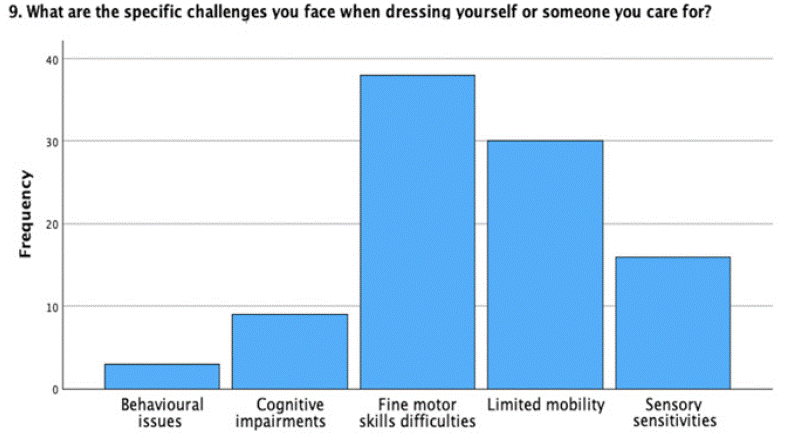
Figure 1: Responses to Question 9.
Additionally, 9 of the participants noted CIs, which highlight the impact of memory and judgment issues on the dressing process. Lastly, behavioral issues were reported by 3 of the participants, thus suggesting that psychological factors can also complicate dressing for both the elderly and their caregiver. These findings underscore the multifaceted nature of dressing challenges, which can significantly impact the independence and well-being of elderly individuals. Figure 2 shows how these challenges affect the elderly in this study. These include 19.6% feel that time and energy consumption are impacted, 17.8% feel impact on daily routine, 12.3% have emotional distress and limited clothing options, 10.4% have increased dependency on others, and 3.1% have safety concerns.
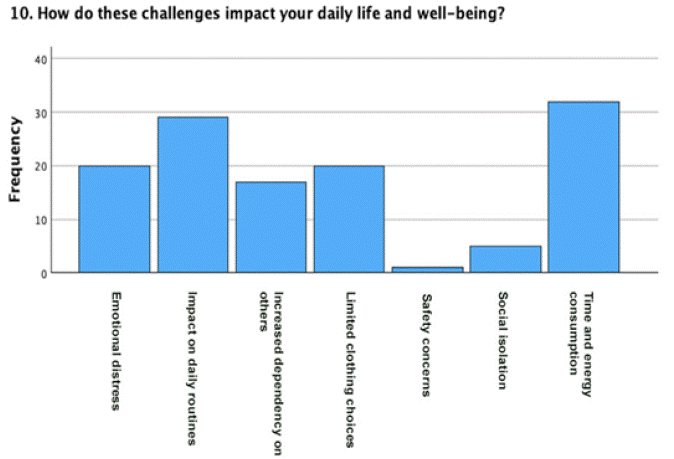
Figure 2: Responses to Question 10.
Dressing with adaptive clothing takes time and effort, thus causing fatigue and disrupting regular routines. Dressing challenges may cause emotional pain, and restricted wardrobe options limit self-expression. Safety concerns and increased reliance reduce autonomy and wellbeing. Older people may have a better quality of life by addressing these issues with efficient designs, more alternatives, and safety precautions. Figure 3 shows the primary body movements or areas that the elderly participants found to be challenging to dress. A significant percentage of the participants, that is, 31% and 30% cited arm mobility and hand dexterity, respectively, as their main concern. Furthermore, 20% of the participants struggle with leg mobility, while 26% have problems keeping their trunk stable. Two of the individuals stated that they do not have any problems with any one body part. The findings highlight the specific physical challenges that the elderly experience while dressing.
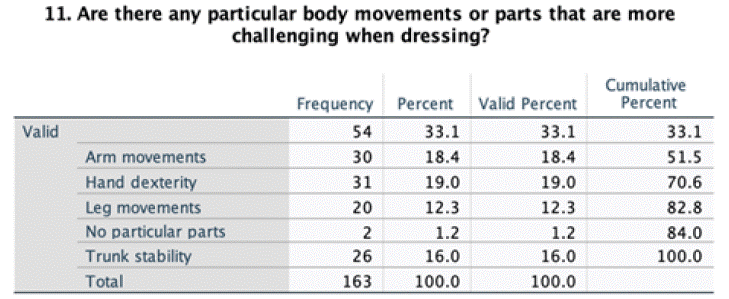
Figure 3: Responses to Question 11.
The following sections discuss the style preferences of the participants and improved adaptive clothing.
Finding 2: Needs and Preferences
In this section, the needs and preferences of the elderly participants for clothing are examined with consideration of wear comfort, ease of donning and doffing, style, and culture.
The participants were asked to identify the features or design elements that would make adaptive clothing easier for them or their caretakers. Figure 4 shows that Velcro or magnetic closure is the most frequently mentioned or indicated by 23.9% of the participants, which would make dressing easier. Another frequently mentioned feature are adaptive fasteners/snaps, with 22.1% expressing a preference for this design element. The participants (11%) also highlighted the importance of elastic/adjustable waistbands, open-back/side-snaps (11.7%), and wide openings/large armholes (14.1%). These features contribute to enhanced wear comfort, flexibility, and ease of dressing [5,6,7].
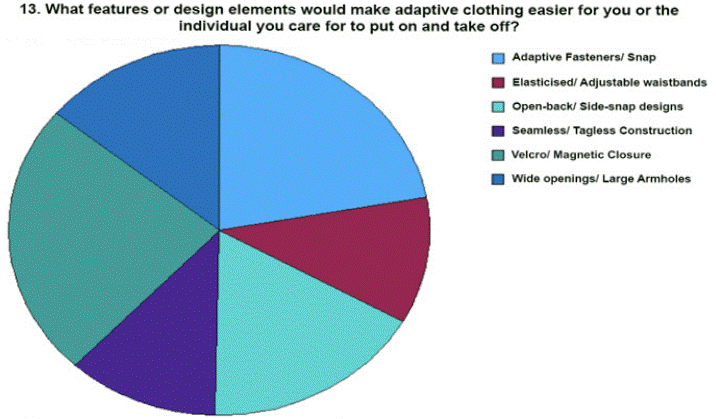
Figure 4: Responses to Question 13.
Regarding style preferences and cultural factors for developing adaptive apparel, one-quarter of the participants (25.2%) favor easy to care textiles that are low-maintenance and require less work for laundering and upkeeping. This corresponds with the inclination towards functionality and ease in selecting clothing options for older people. Furthermore, this prioritizes climate appropriateness, with 21.5% whose focus is placed on the significance of clothing that is well-suited for the specific weather conditions in Hong Kong, given its hot and humid environment. In addition, 22.7% of the respondents value flexibility and adaptability, 7.4% like traditional characteristics, and 6.7% appreciate modesty and covering up. The preferences of the elderly in Hong Kong indicate a desire for clothing that gives sufficient covering, adhere to the cultural standards of modesty, including traditional design features, which can be styled and adapted for various situations (Figure 5).
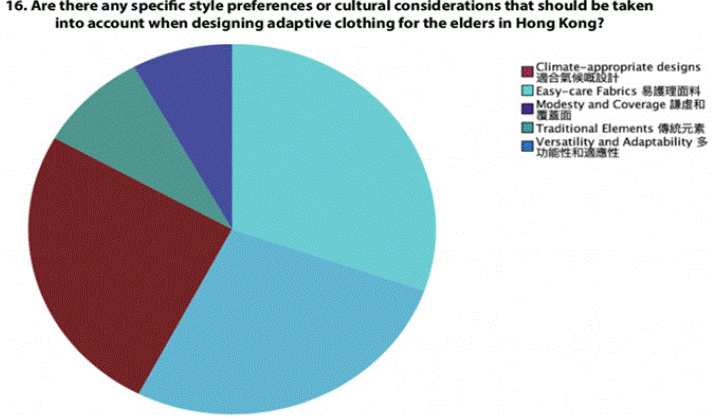
Figure 5: Responses to Question 16.
Close to a quarter or 22.7% of the participants expressed a preference for user-friendly closures as shown in Figure 6. This feature is particularly valued by those with limited dexterity or mobility since it offers ease and freedom. Convertible/adjustable designs, which 18.4% of the participants prefer, are considered to be beneficial due to their capacity to accommodate various conditions and provide both style and functionality. There are respondents (15.3%) who emphasized the need for accessibility for medical procedures, thus underscoring the need for such garments to easily allow inspection, treatment, or surgery while ensuring wear comfort and dignity. A small percentage or 13.5% of the participants indicated a preference for temperature regulation whereas an even lower percentage of 6.7% favor integrated sensory support. These results show the variations in preferences of the participants for extra features and functions in adaptive apparel.
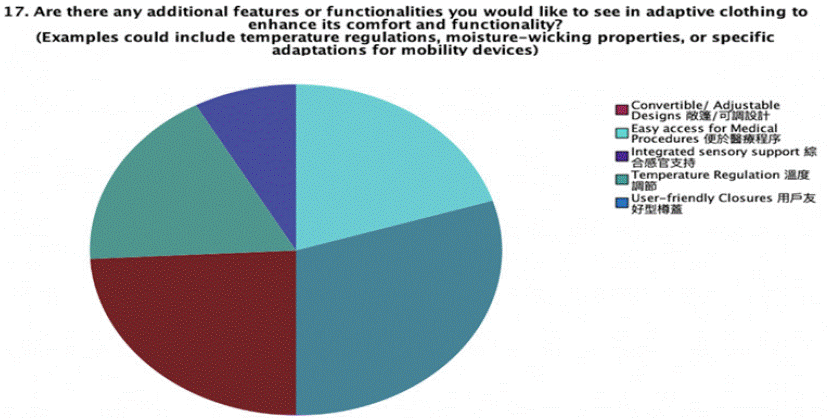
Figure 6: Responses to Question 17.
As for recommendations or suggestions for improving adaptive clothing for the elderly in Hong Kong, 27.6% of the participants proposed prioritizing versatile and adaptive designs. With the hot and humid environment in Hong Kong, 20% of the participants prefer to incorporate breathable and moisture-wicking fabric to control body temperature and keep the user dry and comfortable. Finally, there is emphasis on the relevance of cultural aesthetics (17%) and flexible and user-friendly closures (7.4%).
Finding 3: Design Proposal
This section focuses on the proposed design of a tailor-made vest to offer ease of wear and wear comfort for the aging population. To enhance the quality of the design and user experience, this study addresses one specific dressing challenge faced by the elderly participants. The data primarily collected from Sections 4.1 and 4.2 were used to develop a tailored-made vest to offer functions specifically for female elderly individuals. The particulars of the proposed design are:
• Targeted gender: Female/Male
• Dressing challenge: Fine motor skill difficulties
• Body limitations: Arm movement
• Design element preference: Velcro/magnetic and adaptive fasteners/snaps
• Additional design features: Easy to care textile and climateappropriate design
Vest Design Description: To address the needs of the elderly, a versatile vest designed for year-round use is proposed, which uses a conceptual framework for apparel design [20]. During the design process of this vest, careful attention was given to ensure bodily, psychological, and personal comfort. This vest, as shown in Figure 7, is designed specifically for the elderly who have difficulties with fine motor skills and limited arm mobility. It is also tailor-made for those who value practical clothing options and would like to show that this is their style. A magnetic opening and two pockets with a large zipper head for ease of access are placed at the front of the vest. The seam side of the vest is equipped with angular pintuck details to highlight the silhouette of the user. In Schiehll et al. [21], the primary challenge in putting on tops with a front opening is reaching for the second sleeve from the back. Such key movements involve bending and extending the arms. Velcro on the front and back panels of the vest enhances convenience of donning and doffing for the wearer. Schoeb et al. [22] stated that just under a third of the elderly in Hong Kong experience chronic back pain. To strengthen the back muscles, the design of the vest also has a heat-resistant pouch bag included inside the vest which is followed by a yoke. The user can easily insert reusable heat packs, to warm their lower back and sleep during their use.
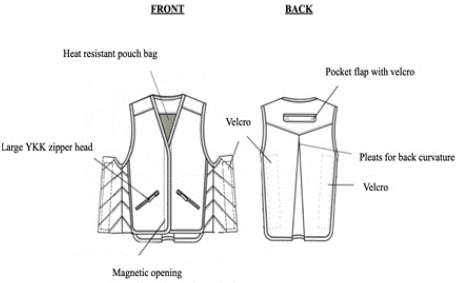
Figure 7: Technical Drawings of Proposed Design.
Design Functions & Details: Adaptive clothing is designed to facilitate ease of dressing for individuals who have physical limitations, thus promoting independence and self-confidence. Design functions like zippers, Velcro, and buttons can be helpful and also much preferred by the elderly [23,24].
The large YKK zippers (Figure 8) on the front vest increase versatility and ease of use. These are a simple closure that can be used by someone with restricted mobility. Zippers simplify dressing and undressing, which saves time and effort. They may also be opened or closed to accommodate different types of bodies. The zipper also keeps clothing in place during movement. Finally, they improve the utility and accessibility of adaptive clothes.
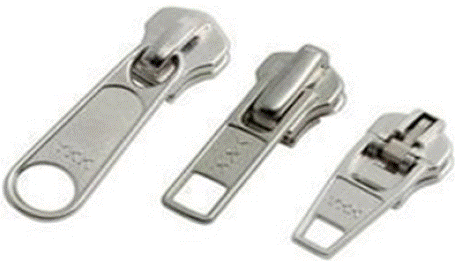
Figure 8: YKK zipper.
Velcro (Figure 9) has long been a preferred choice among designers and manufacturers of adaptive clothing [24]. A Velcro closure on the side and rear is a simple yet effective means of fastening clothing and easily used by someone with limited dexterity or movement. They make dressing and undressing easier than buttons or zippers.
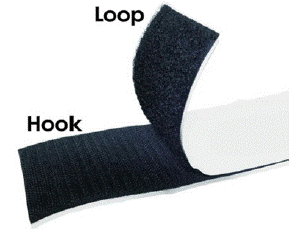
Figure 9: Velcro.
Velcro can be adjusted to accommodate different body sizes and shapes comfortably and securely. Its powerful grip keeps garments attached throughout movement. Velcro fasteners make adaptive clothes more accessible and convenient to don and doff.
However, zippers and buttons may not be as easily accessible for some of the elderly who have problems with their fine motor skills or arthritis. In such cases, magnetic closures (Figure 10) are often used as an alternative [25, 26].
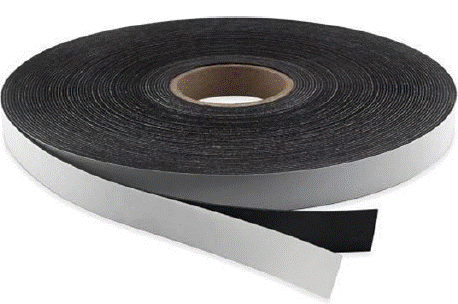
Figure 10: Magnetic strap.
They are simple to position and attach, and secure. Snaps are also easy to handle and close quickly. Both magnetic closures and snaps are dependable and inconspicuous fastenings that keep garments in place throughout daily activities. They make dressing easier and more independent; nevertheless, users with pacemakers may not find them suitable.
Fabrication: In light of the response of the participants to Question 22, wearers can don clothing that allows them to remain dry and comfortable to combat the hot and muggy climate of Hong Kong with the use of natural fibers as they generally absorb moisture very well, thus enabling airflow and preventing overheating; see Figure 7. Cotton or linen is considered natural, as shown in Figures 11 to 14 [27].
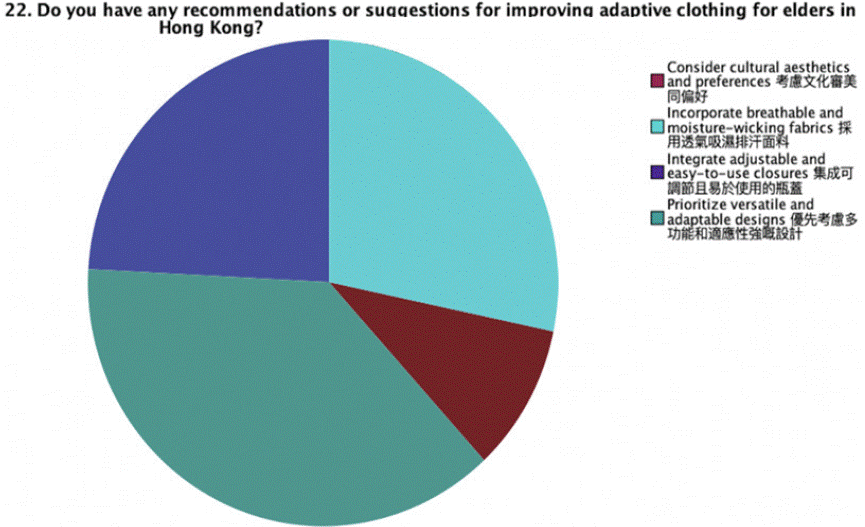
Figure 11: Responses to Question 22.
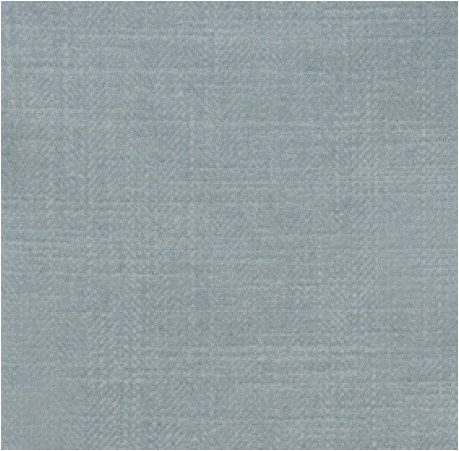
Figure 12: Cotton blend linen.
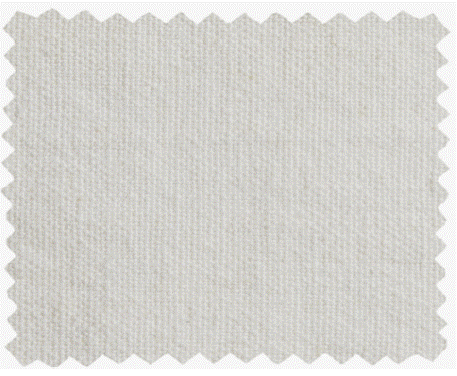
Figure 13: Cotton fabric.
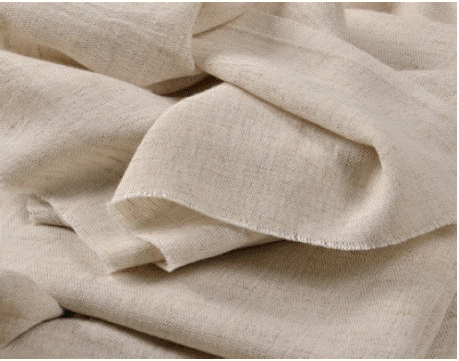
Figure 14: Linen.
This is an important characteristic for those who may have problems in regulating their body temperature. Secondly, these materials are soft, lightweight, and hypoallergic, so they enhance wear comfort and reduce the likelihood of allergies.
Additionally, they can wick away moisture, hence effectively absorbing perspiration and keeping the wearers dry. Last but not least, a wide range of hues and designs are available for linen, cotton, and cotton-linen mixes; therefore, clothing designers can enjoy versatility because they are offered a multitude of stylistic options.
Discussion
The research findings have significant implications for the development and improvement of adaptive clothing for the elderly in Hong Kong. The study reveals the challenges that older people face when they are dressing and identifies the need for age-appropriate The research findings have significant implications for the development and improvement of adaptive clothing for the elderly in Hong Kong. The study reveals the challenges that older people face when they are dressing and identifies the need for age-appropriate [28]. As the demand for fashion among the elderly increases, there is a need for improved aesthetics and better fitting clothing [29]. The fashion industry can play a crucial role in promoting independence and well-being among the elderly population by offering a wider range of adaptive clothing options. In addition, cultural factors should be considered in the design of adaptive clothing. For example, the cultural context in Hong Kong focuses on modesty in the garments of the elderly. The study also highlights the potential benefits of adaptive clothing for caregivers, nurses, and hospital staff in facilitating the dressing and undressing of seniors. Furthermore, the findings have implications for policymaking and healthcare planning. It is worth noting that the projected increase of the aging population in Hong Kong gives weight to the importance of adaptive clothing in promoting the well-being and independence of older people. By considering these implications, designers, manufacturers, policymakers, and healthcare professionals should work together to develop and promote adaptive clothing that meets the unique needs of the aging population. The initiative will enhance the quality of life and foster independence of the elderly. Future research on adaptive clothing can focus on the specific requirements of the respondents that have emerged from the current study.
There are several limitations of this study on the challenges and needs of the elderly in Hong Kong towards adaptive clothing. First, even though care is taken to ensure the results and findings are representative for the aging population at large, the study is only based on a specific geographical location with a limited sample. This shortcoming may limit its generalizability to other regions or countries as a whole. To help overcome the limitation, the sample should be larger to reduce the sampling error. Secondly, the study primarily focuses on upper-body clothing, precisely a tailor-made vest, which may not meet the full range of clothing needs and overcome the challenges faced by the elderly population. Lower body clothing, such as pants or footwear, may present other challenges that are not explored in this study. This may be another research area in the future. In addition, there is a language barrier during data collection, which can potentially lead to inaccuracies or misinterpretations. Future research could involve researchers or language support services that include other languages or dialects to ensure accurate data collection and interpretation. This study relies on self-reported data through 54 surveys, which may be subject to recall bias or social desirability bias. A larger sample size could have provided a more representative picture of the challenges and needs of this elderly population. Finally, the study focuses on the perspectives of the elderly and their caregivers whereas the viewpoints of other stakeholders such as designers, manufacturers, or healthcare professionals and their collaboration are not fully explored in the study.
This study underlines the needs and dressing requirements of this growing population. To expand on this study, there may be ways to improve current knowledge and enhance the creation of adaptive apparel. Examples are new forms of collaboration among designers, manufacturers and other stakeholders, and the incorporation of the opinions of healthcare professionals.
Conclusion
The aforesaid forms of collaboration among the stakeholders can translate research insights into practical design solutions for adaptive clothing. At the same time, the collaboration renders the ability of manufacturing firms to sustain their competitive advantages. Overviews of the stakeholders can contribute to a richer body of knowledge and therefore a better understanding of the benefits and challenges associated with traditional clothing for the elderly. For instance, designers can incorporate features from their research into designs, manufacturers can provide insights into production and scalability, and caretakers can extend beyond the boundaries of the home for the aged to benefit the elderly. This collaboration can address the limited availability of adaptive clothing, and increase production, distribution and accessibility. Knowledge exchange between researchers and industry professionals could also lead to innovations and advancements in the field of adaptive clothing.
Secondly, the opinions of healthcare professionals can provide another perspective to increase the effectiveness of adaptive clothing in enhancing mobility, independence, and overall well-being. They can identify and assess the functional needs and limitations of the elderly, and ensure the design aligns with therapeutic interventions. Occupational therapists can provide ergonomic insights in respect of optimal movement and functionality. Healthcare professionals can also evaluate and validate adaptive clothing solutions through clinical trials or user testing based on their expertise. Evidence-based guidelines could be established for practices in various healthcare settings. Collaboration among textile and clothing researchers and healthcare professionals enables the integration of adaptive clothing into the healthcare system. The collaboration also identifies specific needs and requirements, hence improving patient care, caregiver support, and the overall quality of life for older people.
Funding
This research was fully funded by the University Grants Committee – Research Matching Grant Scheme of Hong Kong Special Administrative Region, China (Project No.RMG026)
Institutional Review Board Statement
This study was conducted in accordance with the Declaration of THEi, and approved by the faculty mini-Ethic Committee, Technological and Higher Education Institute of Hong Kong under the Institutional Review Board Statement.
Informed Review Board Statement
Informed consent was obtained from all subjects involved in the study.
References
- The Legislative Council Commission. Challenges of Population Ageing. 2015.
- Census and Statistics Department, HKSARG. Special Topics Report No. Persons with disabilities and chronic diseases. 2021.
- Mlinac ME and Feng MC. Assessment of activities of daily living, self-care, and independence. Archives of Clinical Neuropsychology. 2016; 31: 506–516.
- Disabled World. Adaptive Clothing for Disabled, Elderly or Physical Disability. 2015.
- Wu M, Jiang Y and Zhang L. Research on the current situation and development trend of adaptive clothing demand. Journal of Innovation and Development. 2023; 2: 29–35.
- Pereira das NÉ. Elderly and clothing: Considerations about handling trimmings. Current Trends in Fashion Technology & Textile Engineering. 2018; 2.
- Kabel A, McBee-Black K and Dimka J. Apparel-related participation barriers: Ability, adaptation and engagement. Disability and Rehabilitation. 2016; 38: 2184–2192.
- Eggleston JM, Bentrem DJ, Bromberg WJ, London SD, Biesecker JE and Edlich RF. Adaptive clothing for persons with mobility disorders after burn injury. Journal of Burn Care & Rehabilitation. 1994; 15: 269–274.
- Park J. Development of an integrative process model for universal design and an empirical evaluation with hospital patient apparel. International Journal of Fashion Design, Technology and Education. 2014; 7: 179–188.
- Sau-Fun N, Chi-Leung H and Lai-Fan W. Development of medical garments and apparel for the elderly and the disabled. Textile Progress. 2011; 43: 235–285.
- Na H-S. Adaptive clothing designs for the individuals with special needs. Journal of the Korea Society of Clothing and Textiles. 2007; 31: 933–941.
- Geri Fashions. Guide to Open Back Tops. 2021.
- Cora J Firkin, Iva Obrusnikova and Laura C Koch. Quantifying physical activity and sedentary behavior in adults with intellectual disability: A scoping review of assessment methodologies. Healthcare. 2024; 12: 1912.
- Walker CM, Sunderland A, Sharma J and Walker MF. The impact of cognitive impairment on upper body dressing difficulties after stroke: A video analysis of patterns of recovery. Journal of Neurology, Neurosurgery & Psychiatry. 2004; 75: 43–48.
- Xiangyu Cui, Xiaoyu Zheng and Yun Lu. Prediction model for cognitive impairment among disabled older adults: A development and validation study. Healthcare. 2024; 12: 1028.
- mmLearn.org. Types of Adaptive Clothing for Seniors. [online] training. mmlearn.org. 2019.
- Au J and Lam J. Predictors of design preferences for older people’s fashion in terms of physical and psychological dimensions. International Journal of Fashion Design, Technology and Education. 2020; 13: 256–264.
- Kabel A. Wardrobe malfunction: Case studies of disability and clothing at the threshold of older adulthood. Journal of Human Behavior in the Social Environment. 2019; 29: 731–743.
- Zeenat Kotval-K and Isha Pithwa. Affinity and usage of technology in general, and telehealth in particular amongst Michigan older adults during the COVID-19 pandemic. Healthcare. 2024; 12: 117.
- Lamb JM and Kallal MJ. A conceptual framework for apparel design. Clothing and Textiles Research Journal. 1992; 10: 42–47.
- Schiehll L, Simões I and Silva FM da. Kinesiological analysis of the dressing process in musculoskeletal patients. Procedia Manufacturing. 2015; 3: 5979– 5986.
- Schoeb V, Misteli M, Kwan C, Wong CWY, Kan MMP, Opsommer E and Wong AYL. Experiences of community-dwelling older adults with chronic low back pain in Hong Kong and Switzerland – A qualitative study. Front. Rehabilit. Sci. 2022; 3: 920387.
- Bezerra LG, Silva ÁP da, Medeiros FG de, Santos JRS and Dantas ÍJ de M. Inclusive thinking in fashion design: Ergonomic and practical apparel for elderly. Research, Society and Development. 2020; 9: e224996857.
- Choudhary C and Poonia N. International Journal of Home Science 2020, 6(2): 238-241 Adaptive Clothing for Disabled People. 2020.
- Preen Suri. CLOTHING NEEDS ASSESSMENT for WHEELCHAIR USERS. 2016.
- McKinney, Ellen, and Rachel Eike. “Introduction: A Guide for Adaptive Apparel Design and Soft Goods Product Developers.” Iastate.pressbooks.pub. 2023.
- Meinander Harriet and Minna Varheenmaa. “Clothing and textiles for disabled and elderly people.” VTT TIEDOTTEITA Research Notes. 2002: 23-37.
- Yeung J and Hui PCL. Study of adaptive clothing in Hong Kong: Demands, analysis and future direction. Advances in Aging Research. 2020; 9: 1–13.
- Au J, Lam J and Ho C. Design preferences and experience of older people’s choice in fashion in Hong Kong. International Journal of Fashion Design, Technology and Education. 2016; 9: 183–191.